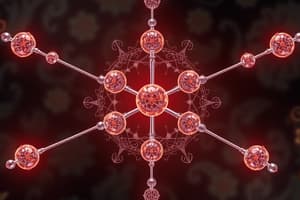Podcast
Questions and Answers
What happens to the bond length as the number of bonds between two carbon atoms increases?
What happens to the bond length as the number of bonds between two carbon atoms increases?
- The bond length decreases as the bonds become stronger (correct)
- The bond length increases due to less electron sharing
- The bond length becomes unpredictable
- The bond length remains the same regardless of the number of bonds
Which statement best describes a dative bond?
Which statement best describes a dative bond?
- Dative bonds cannot involve lone pairs of electrons
- The pair of shared electrons is supplied by one of the two bonded atoms (correct)
- Dative bonds can only be formed between identical atoms
- Both atoms contribute equally to the shared electrons
What characterizes a double bond between two atoms?
What characterizes a double bond between two atoms?
- Sharing three pairs of electrons
- Sharing one pair of electrons
- Complete electron transfer from one atom to another
- Sharing two pairs of electrons (correct)
Which of the following is true about triple bonds?
Which of the following is true about triple bonds?
Which condition is necessary for the formation of a dative bond?
Which condition is necessary for the formation of a dative bond?
What type of bond is formed between nitrogen and hydrogen in the ammonium ion?
What type of bond is formed between nitrogen and hydrogen in the ammonium ion?
When drawing the Lewis structure for water, which atom is placed in the center?
When drawing the Lewis structure for water, which atom is placed in the center?
How many total valence electrons are present in methane (CH4)?
How many total valence electrons are present in methane (CH4)?
Which is the first step in writing Lewis structures?
Which is the first step in writing Lewis structures?
What is one of the requirements for a molecule or ion to have a resonance structure?
What is one of the requirements for a molecule or ion to have a resonance structure?
Which pair of elements is often assigned as the central atom in a Lewis structure?
Which pair of elements is often assigned as the central atom in a Lewis structure?
Which statement is true about formal charges?
Which statement is true about formal charges?
What shape should be expected for a molecule with the formula COCl2?
What shape should be expected for a molecule with the formula COCl2?
Which of the following molecules can have an incomplete octet?
Which of the following molecules can have an incomplete octet?
In Lewis structures, what is typically true of polyatomic species?
In Lewis structures, what is typically true of polyatomic species?
Which of the following compounds can exhibit an expanded octet?
Which of the following compounds can exhibit an expanded octet?
What action should be taken if a Lewis structure contains too many electrons?
What action should be taken if a Lewis structure contains too many electrons?
What condition allows a molecule or ion to have a formal positive charge?
What condition allows a molecule or ion to have a formal positive charge?
Which of the following is an example of an odd electron species?
Which of the following is an example of an odd electron species?
In what case must a molecule have lone pair electrons?
In what case must a molecule have lone pair electrons?
Which of the following is a requirement for a molecule to have a resonance structure?
Which of the following is a requirement for a molecule to have a resonance structure?
What is the purpose of calculating formal charges in Lewis structures?
What is the purpose of calculating formal charges in Lewis structures?
When constructing a Lewis structure, which atom type should typically be placed in the center?
When constructing a Lewis structure, which atom type should typically be placed in the center?
What action should be taken when a Lewis structure has too many electrons after fulfilling the octet rule?
What action should be taken when a Lewis structure has too many electrons after fulfilling the octet rule?
What is the expected formal charge for a stable molecule?
What is the expected formal charge for a stable molecule?
In what scenario would an atom be assigned a formal charge greater than zero?
In what scenario would an atom be assigned a formal charge greater than zero?
What is the first step in writing a Lewis structure for a compound?
What is the first step in writing a Lewis structure for a compound?
If a molecule has a positive charge, how is the formal charge calculated?
If a molecule has a positive charge, how is the formal charge calculated?
Which option best describes the role of d orbitals in Lewis structure construction?
Which option best describes the role of d orbitals in Lewis structure construction?
What does the octet rule indicate about an atom's preferred electron configuration?
What does the octet rule indicate about an atom's preferred electron configuration?
In the formation of NaCl, what happens to sodium's valence electron?
In the formation of NaCl, what happens to sodium's valence electron?
What is the electron configuration of the Na+ ion?
What is the electron configuration of the Na+ ion?
What is the approximate electron configuration of Cl- ion?
What is the approximate electron configuration of Cl- ion?
What type of bond is formed between Na+ and Cl- ions?
What type of bond is formed between Na+ and Cl- ions?
Which of the following statements is true regarding covalent bonds?
Which of the following statements is true regarding covalent bonds?
Which element has an exception to the octet rule due to its electron capacity?
Which element has an exception to the octet rule due to its electron capacity?
What happens to chlorine atoms when they form ionic compounds?
What happens to chlorine atoms when they form ionic compounds?
Flashcards are hidden until you start studying
Study Notes
Bonds and Examples
- Carbon monoxide (CO) features a coordinate bond between carbon (C) and oxygen (O).
- Ammonium ion (NH4) forms when ammonia (NH3) gains a proton (H+).
- Hydronium ion (H3O) results from water (H2O) accepting a proton.
Drawing Lewis Structures
- Start by counting total valence electrons; add or subtract electrons based on ion charges.
- Construct a skeletal structure connecting atoms with bonds.
- Place the least electronegative element in the center of the structure.
- Complete the octet for all atoms except hydrogen, which follows the duet rule.
- If necessary, create double or triple bonds to accommodate too many electrons.
Octet Rule
- Atoms seek to have 8 electrons in their highest energy level to achieve stability.
- Sodium (Na+) loses one electron to achieve a stable octet, while Chlorine (Cl-) gains one.
- Sodium chloride (NaCl) forms when sodium donates its valence electron to chlorine.
Types of Chemical Bonds
- Ionic bonds occur via electrostatic attraction between positively and negatively charged ions.
- Covalent bonds share electrons between atoms, including single, double, and triple bonds.
- Hydrogen is a special case, only able to hold 2 electrons due to its position in the periodic table.
Bond Lengths
- The bond length decreases as the number of bonds increases; for example, C-C bond lengths are:
- Single bond: 1.54 Å
- Double bond: 1.34 Å
- Triple bond: 1.20 Å
Dative Bonds
- Dative (or coordinate) bonds occur when one atom donates both electrons for bonding.
- For dative bonds, the donor must have a lone pair of electrons, and the acceptor should have an empty orbital.
Writing Lewis Structures Steps
- Arrange remaining electrons to satisfy hydrogen's duet and other atoms' octets after forming initial bonds.
- If insufficient electrons remain, employ d orbitals from Period 3 or beyond to expand octets.
- If there are extra electrons, form multiple bonds as needed.
Formal Charge
- Formal charge assesses the distribution of electrons in a Lewis structure, with the ideal being closest to zero.
- The sum of formal charges should equal zero for neutral molecules or the overall charge for polyatomic ions.
- A stable Lewis structure has minimal formal charges and negative charges on more electronegative atoms.
Resonance Structures
- Molecules with multiple bonds and lone pairs can exhibit resonance.
- Structures must have valid electron pair arrangements to describe resonance effectively.
Exceptions to the Octet Rule
- Incomplete octets occur when central atoms possess fewer than 8 electrons, as seen in boron trifluoride (BF3).
- Expanded octets are observed in elements like phosphorous and sulfur.
- Odd-electron compounds, such as nitric oxide (NO), do not adhere to the octet rule.
Studying That Suits You
Use AI to generate personalized quizzes and flashcards to suit your learning preferences.




